I hadn't seen that behavior before, and I kind of panicked as there was something about the bees hanging out like that because they were thinking of swarming, but usually it's a huge beard of bees, not just a few wandering aimlessly outside...
So that night, I just went and put another box on top, just in case. I knew that I was going to have to do an inspection soon, but I wanted to wait until it was mid-day and I had enough time and patience to do it right. So I planned to go in on Tuesday, when I would have John at home and I knew the weather would be clear.
I also went to the Internets, and they said no worries, if the ladies are hanging when it's hot, it's likely just a way to cool off and to help keep the hive from overheating. That I should look to give them better ventilation and or more cooling options. I also read up on more ways to do a bottom-up inspection when I had multiple boxes stacked on.
The top box that I'd put on was completely empty of anything but a few curious bees. It was easy to lift, and I just stacked it on an upside down doormat I'd put out of the flight path. The top brood box was a lot harder to lift. *laughs* I've been doing dead lifts with the weightlifting system that
The real problem was that John had built a little platform for the hive over the window well of our basement. The well has a mesh over it that was solid enough for careless two, three, or even five-year-olds, but it can't hold the weight of an adult human being, not to mention such a human being with another thirty pounds of beehive. I had to stand on the rim of the well, reach, and lift the hive body and carefully bring it to me so that I didn't shake any of the girls out of the completely open bottom.
As you can see from this picture, the girls started to build linking comb from the bottom box to the top one, so it was kind of important that I take all that apart.
The bottom of both boxes has to be open to allow passage between the two levels and to let air circulation happen. The bees are very good at clinging to their frames, but... it was still kind of hairy doing it. Both my boys watched very carefully to see that nothing but a bit of honey dropped from the top box before I had it on top of the topmost level that was resting on the mat.
Very busy girls. There was one entire frame that was utterly empty, one that they'd started one, but then the next six were chock-a-block with bees, brood and honey. This was one of the brood frames, and they'd just kept building. This is just comb on the bottom, but I needed John to take a picture so that I could be sure that it wasn't a queen cell.
Yes, that's Jet in the background. He'd donned my extra veil and hat and was watching me do all this from very very close up. He wasn't bothered by any of the girls at all, and was fascinated with the whole procedure! I loved his interest and it was really nice to have him there as yet another pair of hands while John was handling the camera, the smoker, and other things.
This made me very happy, as it's a frame that's almost completely covered, edge to edge, with capped brood. The eggs develop into larve, which then get fed until they're fat enough to be covered. They spin their coccon after that, and under go metamorphsis over the last two weeks of development. So all of these were laid within a week of each other, for nearly all of them to still be under caps. So the Queen's been very very busy, and doing a very good solid job of laying in nearly every cell.
It was interesting to me, though, to see the wax over the top bar, and that they just kept going with the cells.
This was beautiful and brand new to me. This is a frame with nothing but honey. There was one of these on each level, where it was nothing but honey. Both boxes also had one frame where the outside of them was all honey and the brood side of them had about half a side of brood and all the outside was honey. Those were pretty heavy as well.
I was astonished at just how heavy these were!! But front and back, this frame was nothing but honey. This side was all capped, as it had dehydrated enough to be thick enough for them. The other side, though, was open and still drying out. That might have been another reason for the bees that were outside the hive during the night. The extra humidity in the hive was only added to with more bees in the hive, so in order to allow the drying action to happen, they stayed outside.
Once this is capped, there might be less humidity in the hive. I'm kind of hoping.
Then I ran into an interesting problem.
I had had one frame in the bottom box that the girls had doubled the comb up on me on the frame. They'd hung another sheet of comb from the top bar, simply because there was too much space in that box. I am trying to fix it by spacing the frames in there closer together and leaving that extra space on the sides, but... at the beginning I didn't know there was even a problem, until they'd already built the comb.
This time, when I went in, I found that second sheet already fallen from the bar, and lying in the bottom of the box. It had been supported by the frame it had been hanging with, but had clearly broken free a while ago and was just slumped. Luckily, it had probably fallen a while ago, so the Queen hadn't laid anything more in it. Unluckily, there were still a few bees just barely fully developed still in the cells, struggling to get out. I ended up rubberbanding what was left of this into an empty frame, and inserting it into upper box, replacing one of the completely empty frames, and moving all the full frames over one slot to cover the empty areas.
I know, it was a lot of manipulation, but I really wanted to get an empty foundation and frame where they were doing the most honey making, and I wanted this slab of a mistake out of there. In the picture there's actually a dozen bees trying to help the baby bees out and feeding them.
John, in the meantime, got some amazing shots from the boxes I wasn't paying attention to. *laughs* I didn't have any problems with any other hives trying to rob this one, so I just left all the boxes open while I worked.
The top box was 3/4 full, too, and, as I said, I moved all the full ones over to give room for another empty frame. Then two days later, on Thursday, I suited up and went back in to pull out the 'empty' frame and found it covered with bees trying to fill it with honey!
I smoked most of them off, and just tapped the rest of them off back into the hive, after making sure the queen wasn't with them. Most of the bees that were in cells on that piece had already been born. I freed one more, right there, and put her back into the hive so she'd have a chance, and then we threw the piece of comb away, and tucked a clean, new frame in there with just fresh foundation for them to draw out and fill.
They'd already drawn out one new leaf of comb, but it was small, and I didn't feel badly about taking it. The interesting thing is that the comb cells were much, much bigger than the ones that the workers built in traveling box! I wasn't sure why that was so.
They've been pretty enthusiastic builders. I cleaned off all this protruding comb. But both top and bottom boxes have empty frames, still, and there's nothing like a queen cell anywhere. So no real threat of swarming. I added a spacer between the lid and the boxes so that there could be more air flow. I'm not sure it's enough. I might want to remove the inner lid and just have the telescoping lid on top of the spacers, but it's not as easy to clean as the inner lid.
So the usual schedule of adding a super in July is about right for these girls, and I'll be doing that sometime next week. I don't want to be bugging them so much.
The good news is that night, when it was pretty cool, all the girls were in the hive. There's plenty of room for them, I think, still, and so long as it's cool enough, they're happy to stay within where it's safe.
The other interesting thing was that when I tasted the honey I'd gotten from scraping off the cross-frame comb, it was sweet and floral and smoky. I wonder if some of that forest fire smoke got into their honey?
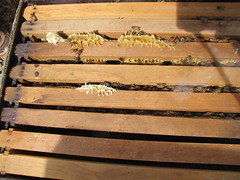
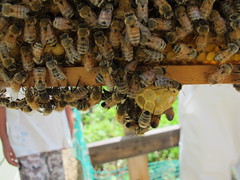
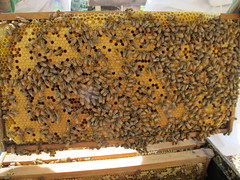

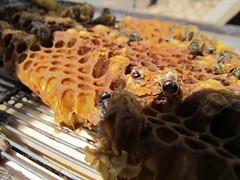
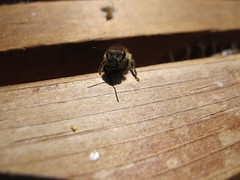
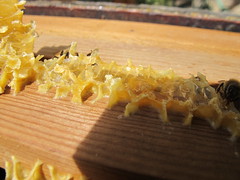
No comments:
Post a Comment